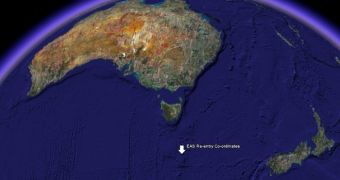We have recently written a piece on the Early Ammonia Servicer (EAS) device that NASA astronaut Clayton Anderson threw overboard on July 23rd, 2007. Although it was not a small object, no official announcement was made so as to warn the public of the danger it might pose upon entering the atmosphere, possibly because NASA rigorously tracked it down.
The object weighed 1,400 pounds (635 kilograms), and floated for more than a year (15 months, to be more precise) before reaching Earth at a speed of about 100 mph (160 km/h).
Calculations indicated that the EAS would not remain in the original form that it bore when it was tossed away from the International Space Station, but would instead chip off into approximately 15 pieces, ranging in dimension from 1.4 ounces (40 grams) to about 40 pounds (17.5 kilograms). The object was expected to fall on November 3rd and, while there were no eye witnesses to attest the event, it is certain that the event took place.
A calculation of the impact timing, based on the tracked trajectory, indicated that the EAS must have entered the atmosphere on November 3 at 04:51am GMT, with an error margin of 1 minute, according to the US Space Command, as cited by SpaceWeather. The location was determined to be 48 degrees south, 151 degrees east, in the Pacific Ocean, close to the border with the Indian Ocean, and about 550 km far from the Australian state of Tasmania.
This would explain why there were no victims (luckily, but it was pretty close, though) and no eye witnesses. Perhaps the items will also be recovered in time, because it would be a shame if more garbage was added to the long list of ocean pollutants, especially since Mike Suffredini, the program manager of NASA's space station warned that, “If anybody found a piece of anything on the ground Monday morning, I would hope they wouldn't get too close to it.”

 14 DAY TRIAL //
14 DAY TRIAL //